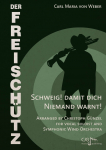Inspired by the natural beauty of my immediate surroundings and by my concerns about the environmental future of our planet, I composed GAIAN VISIONS in July of 1990 during a residency at the MacDowell Colony in Peterborough, New Hampshire. The title of the work refers to Gaia, the Earth goddess of ancient Greece, and to British scientist James Lovelock's Gaian hypothesis, which holds that the Earth is a living, self-regulating organism that is capable of annihilating anything it perceives to be a threat, including the environmentally-destructive human race itself.
The work is in three movements:
I - Forgotten Forests. This section depicts the imposing grandeur of Gaia.
A whirling, animated texture, representing the timelessness of nature, is created by the juxtaposition of independent rhythmic layers. The layers, in order of descending importance, are:
1 - a half-note ostinato in the third clarinets and vibraphone;
2 - a quarter-note ostinato in the piccolo, xylophone, and glockenspiel;
3 - a constant flow of undulating eighth-note chords in the saxophones and horns;
4 - a series of triplet arpeggios in the first and second clarinets; and
5 - a profusion of busy sixteenth-note scalar passages in the flutes.
On top of this conglomerate, the brasses engage in a rapid interchange of short, fleeting gestures that emerge to the foreground, then quickly recede. The tension mounts, unleashing a climactic succession of open brass sonorities (beginning in measure 71). The movement ends with hints of a bird, a frog, distant thunder.
II - Desecration. This section depicts the environmental plagues of modern society.
Relentless rhythms and wild, tonally ambiguous harmonies function as the primary driving forces. A rapid three-note call is the main melodic idea. The dramatic climax of the movement occurs when the open brass theme from the first movement (representing Gaia) returns in conflict with the material of the second movement. The movement ends in an unresolved explosion of sound.
(There is no pause between movements II and III.)
III - Redemption. This section depicts a hope-filled prayer to Gaia.
The main melody is first stated by the oboe, then passed throughout the ensemble in several keys, accompanied by a pair of lower lines which ascend deliberately by step over a period of twenty-one bars. The goal of this rising texture is articulated by a final impassioned statement of the melody. A brief coda follows, alluding to the material from the first movement. The ending is unresolved, an unanswered question.
ACKNOWLEDGEMENT
GAIAN VISIONS was commissioned by the Gamma Phi Chapter of Kappa Kappa Psi, in honor of Dr. Donald E.Bowen, fifth president of Stephen F. Austin State University. On February 22, 1991, the world premiere of GAIAN VISIONS was given by the Stephen F. Austin State University Symphonic Band, John Whitwell, conductor, in Kansas City, Missouri, at the 50th-anniversary convention of the College Band Directors National Association.



